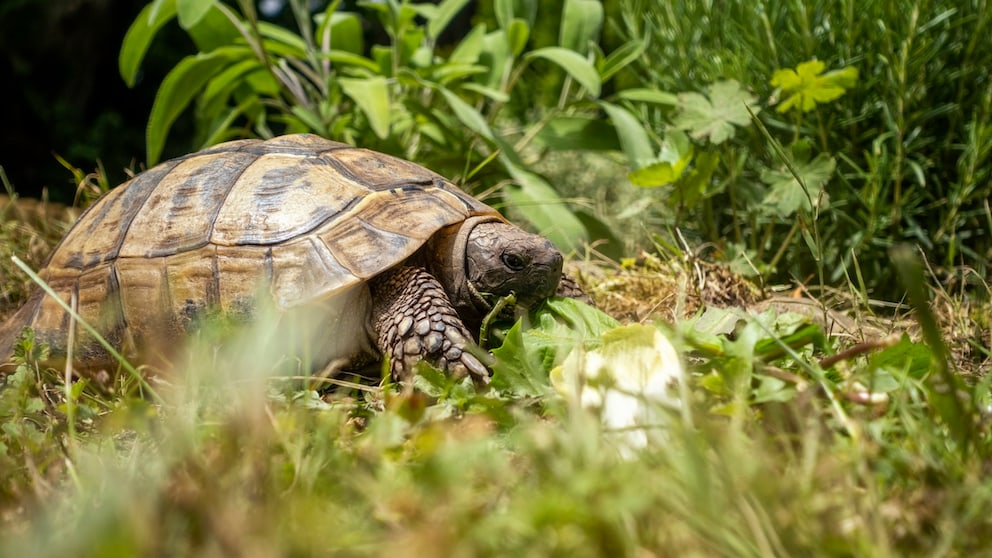
March 29, 2025, 9:46 am | Read time: 6 minutes
Tortoises are not animals for spontaneous purchases — keeping them is more demanding than many people think, especially if you want to keep them outdoors in a species-appropriate way. Anyone who thinks a terrarium and some lettuce are enough is very much mistaken. Experts reveal what is really important with clear advice and recommendations.
Tortoises are among the most popular terrarium pets. It’s easy to see why — tortoises boast a long lifespan, relish time spent outdoors, maintain a serene demeanor, and are the perfect companion for individuals with pet hair allergies. However, “thorough preparation is essential for the care of such an animal,” emphasizes Patrick Boncourt, an expert on exotic animals at the German Animal Welfare Association.
This encompasses the purchase or establishment of a cold frame or greenhouse, the acquisition of technical equipment like fan heaters and UV lights, and ensuring responsible hibernation practices and proper nutrition. Prospective tortoise owners should seek guidance from reputable breeders or animal shelters.
An Animal for the Garden — Not a Pet for Children
To begin with, the Greek tortoise, which is commonly kept in Germany, is a solitary creature and not suitable as a pet for children, according to Boncourt. And: “If you want to keep your tortoise in a species-appropriate way, you definitely need a garden,” says author Svenja Wilms (Landschildkröten. So geht es dein Tiere gut).
These creatures require the sun’s UV light for healthy growth. The changing day and night temperatures are also important for a natural activity cycle. Boncourt notes that confining tortoises strictly to terrariums is now acknowledged as a violation of animal welfare and is thus prohibited.
Tortoises Should Have as Natural a Habitat as Possible Outdoors
What should the tortoise enclosure be like? According to the German Animal Welfare Association, a tortoise living alone needs at least ten square meters of floor space. The structure of the enclosure is also crucial, says Wilms.
In addition to various sunbathing options, it also needs shallow water points with bathing opportunities, caves, lush vegetation to hide in, digging opportunities, branches, stones, and roots. A substrate composed of a blend of limestone gravel and soil is appropriate.
Tortoises Need a Cold Frame and Greenhouse Outdoors
A cold frame or greenhouse should be integrated into the enclosure so that the tortoises can be kept outdoors even in bad weather. “Instead of a cold frame for lettuce from a discount store, you should opt for a specially designed turtle cold frame with walls that are UV-permeable,” advises Boncourt.
The panels should be at least 10 millimeters thick. For a size of one by one meter, you should expect to pay at least 1000 euros. According to Svenja Wilms, you also need an automatic cold frame opener to ensure that the lid opens on hot days.
The benefit of a greenhouse lies in providing the tortoise with ample space to remain active, even during inclement weather. In any case, various warm areas must be created, as well as a sleeping area with a sleeping house that is cool and slightly damp. Roots, stones, and plants ensure that the animal feels comfortable.
Pay Attention to Temperature and Humidity
According to the Animal Welfare Association, the floor temperature should be 22 to 28 degrees, and the local air temperature should be 28 to 30 degrees. Svenja Wilms recommends that the floor should be heated up to 34 degrees in at least one place. A temperature gradient must allow for a change in different zones.
At night, a drop to 17 to 20 degrees is necessary. In addition to the temperature, humidity and sunlight also play a major role in the animal’s well-being, says Patrick Boncourt. For example, the humidity should be 50 to 70 percent.
Heat and Light Sources Are Vital
Additional heat and light are essential. There is a wide range of products on offer, from heating cables and heating mats for the sleeping house to spotlights and UV and heat lamps that can be controlled by timers or a thermo-timer.
According to Svenja Wilms, the lamps should burn for several hours during the day and for shorter periods in summer as required. From mid-November, the lights should burn for one hour less each day and then be switched off completely from December to February.
It is important to find out exactly what the best individual solution is for the enclosure, says Patrick Boncourt. The wrong light can be dangerous for the animals. Too little sunlight or UV light can also lead to diseases.
The Right Diet
“The biggest mistake you can make when keeping tortoises starts with their diet,” says the exotic animal expert. Tortoises are vegetarians and need a high-fiber, low-nutrient diet. Wild plants are best, and they ideally also grow wild in the enclosure.
Dandelions, lettuce, milk thistle, ground elder, nettles, butterfly plants, and labiates are suitable. Buds, flowers, seed capsules, and roots of many plants, as well as the leaves of fruit trees or raspberry, hibiscus, or rose bushes, are also suitable. The tortoise also needs calcium, which can be obtained from cuttlefish shells.
Overwintering in the Fridge
Between November and March, tortoises must hibernate from the age of one — ideally at 4 to 6 degrees in a stable ambient temperature. “Hibernation is very complex and time-consuming,” says Patrick Boncourt.
In September, you start to cool the animal down slowly and gradually by one to two degrees over several weeks. As early as August, you should have a vet check a fecal sample for parasites so that medication can be administered and metabolized in good time if necessary.
There are several options for overwintering. A refrigerator is one of the best solutions for biologists because it is easier to control for beginners. The tortoise is placed inside a household box with a secure, ventilated lid that has been perforated with air holes.
The box is covered with soil, and beech leaves are placed on top, according to Svenja Wilms. The container must always be kept moist, and the fridge must opened once or twice a day for fresh air. Patrick Boncourt advises checking the weight occasionally. Weight loss could be a sign of a serious illness.
Alternatively, you can create a deep, mouse-proof pit in the outdoor enclosure for hibernation, which is filled with soil and into which the animals can dig themselves. “For me, this is the most natural and, therefore, the most species-appropriate option because the animals can prepare for hibernation on their own and also hibernate in this place,” says Svenja Wilms.

Coming out of hibernation How to set up a cold frame for tortoises

Wave of exotic animals being sold Reptile owners want to get rid of their pets due to high energy costs

Keeping them in a terrarium How can you provide newts a species-appropriate home?
In Spring, Tortoises Returns to the Outdoors
In March, the animals leave their pit or have to be moved from the fridge back into their enclosure and slowly acclimatized to higher temperatures. Following the month-long hibernation, enthusiasts can once again delight in observing their tortoises.
“That’s what makes these animals so fascinating for me,” says Svenja Wilms. “Of course, they are not cuddly animals, but you can learn a lot by observing them and discover many differences in their nature and behavior.”
With material from dpa

